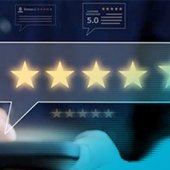Microsoft GM of Global Advertising: AI-driven personalization will fundamentally reshape CX
IN BRIEF
- “We really look to lean into AI and other technologies to really help us move faster and scale.”
- “Our ability to really connect marketing with product now has increased substantially and it’s kind of a virtual feedback loop to really help us develop better products for our customer needs.”
- “Having leadership that does believe in marketing and does believe in the value of brand building is really paramount to the success of, I think, any marketing team.”
In this VISION by Protiviti interview, Protiviti director Greg Hunter sits down with Carol Phillips Hutchinson, General Manager of Global Advertising at Microsoft, to discuss her more than 30 years at the firm leading a creative team that develops and articulates the overall advertising strategy worldwide, including AI-driven personalization that will completely reshape the overall customer experience.
In this interview:
1:25 – The evolution of customers at Microsoft
4:21 – Technology and pace of change challenges
10:10 – Balancing brand and product
13:24 – The next challenge for leaders
Microsoft GM of Global Advertising: AI-driven personalization will fundamentally reshape CX
Joe Kornik: Welcome to the VISION by Protiviti interview. I’m Joe Kornik, Editor-in-Chief of VISION by Protiviti, our global content resource examining big themes that will impact the C-suite and executive boardrooms worldwide. Today, we’re exploring the customer experience and we’re thrilled to have Carol Phillips Hutchinson, general manager of global advertising at Microsoft, where she leads a creative team that develops and articulates the overall advertising strategy worldwide. Today, she’ll be speaking with my Protiviti colleague, Greg Hunter, director, digital media, media, experience, and creative. Greg, I’ll turn it over to you to begin.
Greg Hunter: Thanks so much, Joe. And Carol, thank you for joining us today for this discussion.
Carol P. Hutchinson: Oh, I’m happy to be here. I appreciate you asking me for it.
Hunter: Of course, it’s fun to be talking with you, you know, for as long as we’ve worked together and partnered together. So this is super fun for me as well. So we’re talking about customer experience and obviously, you know, you’ve been at Microsoft for over 30 years now, which is crazy to see how time flies, right?
Hutchinson: Yes, that’s for sure.
Hunter: I’m just curious, how have you seen over time customer expectations have changed, you know, when you consider the customer experience of your customers at Microsoft?
Hutchinson: Well, you know, if you look at kind of the evolution of our—even our products, marketing aside, you know, we used to ship our products in a box and you’d go to the store, you’d bring home a box, you’d upload, ton of floppiness. I’m really aging myself. Then you would have that kind of one-way experience with Microsoft providing you with whatever tools you’re using and you would have that experience within and you might wait a handful of months for an update or a patch or what have you. And we’ve gotten to the point that we have this kind of, we have this relationship back and forth with our customers. We’re not just presenting products and our marketing for them to consume, but we really are having much more of an interactive sort of relationship with them. From product perspective, this enables us to build stronger products to meet our customer needs. From a marketing perspective, it’s incredible. It gives us so much more fidelity in terms of what we know about our customers and what sort of relationship we can have with them when we think about how we want to connect with them from a brand perspective or a product perspective.
Hunter: Interesting, do you think part of that, those expectations, how they’ve changed, also reflect your ability to do hyper-personalization for those experiences just with the real-time data and just how they’ve experienced the brand and all you know about them?
Hutchinson: Yes, yes. I mean, we have this level of understanding of our customers that we’ve never had before. We really have an incredible level of depth of who they are. We’re not just reaching them on a very broad basis, but we know if they’re using our products in the office context, or if they’re using it in the personal context, or if they are a healthcare information worker. We have such an incredible understanding based on our ability to touch and understand where our customers are at that we can also have a much more relevant message to them from a marketing perspective.
Hunter: It’s exciting to see that transformation happening at such a feverish pace and your ability to really develop those relationships, but it also creates this challenge with those changing expectations. So, as I think about the customer experience, it’s increasingly complicated because you’ve got your brands, platforms, channels, technologies, you name it, the proliferation right now of how AI is evolving almost daily in some ways. How do you approach that pace of change being so great with your ability to meet those customers’ needs and keeping up with the adoption of these technologies just to further that relationship?
Hutchinson: Yes, I mean, I think we probably all feel like we are not doing enough and not keeping up enough. Although, when I kind of zoom out and I talk with colleagues across other industries and so forth, I’m like, oh gosh, we really, we are pretty front-footed on all this stuff. But we really look to lean into AI and other technologies to really help us move faster and scale. We have the ability to reach customers in so many different touch points and so many different life stages across so many different platforms, enables us to really get focused on where they’re at and meeting them where they’re at with messages that are relevant to them. But with that comes, as you talked about, an inherent complexity. You have all of these channels you’re leaning into. You have all of these different customers within the channels. You have different product sets within that you want to communicate with. So how do you really keep up with all of that? We’ve really needed—we’ve really leaned into not only kind of internal tools, but external tools and partners to really help us meet kind of the breadth and depth that is necessary in today’s media to be relevant and really connect with our customers.
Hunter: That’s great. I think, thinking back about a recent conversation that we had, you had mentioned something about inspiring, or these customer use cases being inspired by users. Can you talk a little bit about what you mean by that and how that comes to life with creating a customer experience?
Hutchinson: Yes, I mean, again, as you had noted at the beginning, I’ve been around for a while. So in the prehistoric days when I started doing this sort of work, we had good thoughts and we had good ideas for how customers would be using our products. And we do user studies and what have you. But we now are able to take a look at our user logs and really get a sense for how these products are being used and how, and it’s these sorts of actual use cases that people are using our products for that really inspire the work we do. We’re hitting these customers, they’re downloading the products and using again, and when we can continue to kind of educate and give them reasons to come back and utilize the product again and again, that’s a win across the board. That’s educating our customers on different things they could do with our products that they may not have known. Also it helps from a business perspective and a product perspective of getting richer usage. And so we find our ability to really connect marketing with product now has increased substantially and it’s kind of a virtual feedback loop to really help us develop better products for our customer needs.
Hunter: So we talked a little bit about personalization. AI clearly has come up in the conversation, but taking the two of those together, I’m curious, how is AI-driven personalization transforming that customer journey?
Hutchinson: Yes, I think AI driven personalization is fundamentally reshaping the industry. I mean, it’s shifting it from a more generic and linear approach to a much more dynamic and predictive and tailored approach. So whether it’s surfacing the right product or guiding the workflow, it enables us to meet customers in relevant moments and enables us to really scale that engagement as well. But with this sort of power also comes responsibility. So we know that privacy has always been paramount to us, as has trustworthy computing. So that is something that is a part of our DNA. As data is the foundation of AI, our priority is to also ensure that our customer’s data is protected and compliant throughout all of our touch points. So that’s something that is top of mind. We have really, really smart guardrails throughout the process to ensure that we are using everything appropriately. Trust is paramount to what we do. It always has been. It’s not worth compromising that for how we bring customers.
Hunter: It’s hard to build a relationship with a customer you don’t have trust to begin with. It’s pretty much impossible. So let’s switch gears for a second because I know this is near and dear to your heart in particular is about brand. How do you balance both brand marketing and advertising with product and thinking about the users and conversions? I guess, really focusing on that upper funnel of awareness to the lower funnel of conversion. How do you balance the two?
Hutchinson: I mean, balancing brand and product isn’t just a marketing challenge. It’s a strategic imperative, right? So we don’t think of brand and performance efforts as separate. They’re really part of that connected user journey. So if we’re doing our product advertising right, we’re also lifting that brand. So that is something that we always keep in mind with the work that we’re creating. But to your point, there’s been, especially in the past couple of years, a definite favor to kind of that performance level and being able to see immediate ROI on everything that you’re bringing to market. We’re no different than I think most any other companies. We love to see that. We love to be able to see those immediate results. But I think the key is this marketing funnel all has to work together. So in order for that to work as efficiently as possible and that performance layer to work as efficiently as possible, it is much more effective when you do have all of the funnels working together, including the upper funnel to kind of build a broader, to speak to a broader set of customers and then ideally pull them through the funnel. But it’s always, it is balancing act.
Hunter: Absolutely. I would imagine too, that it requires advocates at the senior executive level that believe in brand to also fund these activities.
Hutchinson: Yes, that’s right. That’s right. I mean, I think across any organization, having that leadership that does believe in marketing and does believe in the value of brand building is really paramount to the success of, I think, any marketing team to ensure that, not just the kind of short-term results are in mind, but as we look ahead and look to build for the future of the brand and our future customers that we look past that as well. So again, I think if you can get all of it working simultaneously together, that’s really the sweet spot.
Hunter: Well, when you figure that out, will you let me know?
Hutchinson: Yes, you bet, you bet.
Hunter: Working in concert together like that.
Hutchinson: It will be my next business idea.
Hunter: Right. [Laughter] So the last question for you before I let you go. So given all that we’ve discussed and you just mentioned, thinking about the future, what should business leaders, and as you think about your leadership team and stuff, what should we expect over the next two years?
Hutchinson: As I look ahead, I think that personalization and customization of messages are going to be more and more rich and we are going to be able to touch customers in ways we have never done before. I think ensuring that you foundationally are set up well and as you know, the better organized you are and foundationally secure you are, you can use that foundation to really build your AI solutions and your marketing against, that is critical to have that sort of really relevant set of content and assets. It’s challenging to build and learn and build and learn from that. So I think thinking strategically about not just what you need to accomplish this quarter, but what you hope to accomplish five quarters down the road is really critical to that thinking to ensure that you’re prepared for tomorrow.
Hunter: Absolutely. Well, this has been a great discussion. I so appreciate your time.
Hutchinson: Likewise, Greg, as always. Appreciate it and you, and it’s been so incredible to partner with you over the years. So I look forward to more ahead.
Hunter: Thank you so much.
Hutchinson: You bet.
Hunter: With that, Joe, I’m going to turn it back to you to take over from here.
Joe Kornik: Thanks, Greg. And thanks, Carol. Thank you for watching the VISION by Protiviti interview. On behalf of Carol and Greg, I’m Joe Kornik, we’ll see you next time.
Carol Phillips Hutchinson is the General Manager of Global Advertising at Microsoft where she leads a creative team that develops and articulates the overall advertising strategy cross-portfolio. With over 30 years of experience in marketing communications, Carol has a proven track record of launching, growing and sustaining global brands through strategic planning, audience insight analysis, and rich creative expertise. Her notable achievements include being named Cannes Creative Marketer of the Year in 2021, creating some of Microsoft's top-performing Super Bowl ads, and launching Microsoft Surface.
Greg Hunter is Director, Digital Marketing, Media, Experience & Creative for Protiviti. Greg is an accomplished sales and marketing executive and client leader with a unique blend of client-side, platform, and agency experience. He has extensive experience developing strategies that drive results and revenue streams, and a proven ability in building, developing and leading high-performing teams driven toward lasting client relationships, award-winning client successes, and profitable revenue growth.
Did you enjoy this content? For more like this, subscribe to the VISION by Protiviti newsletter.











